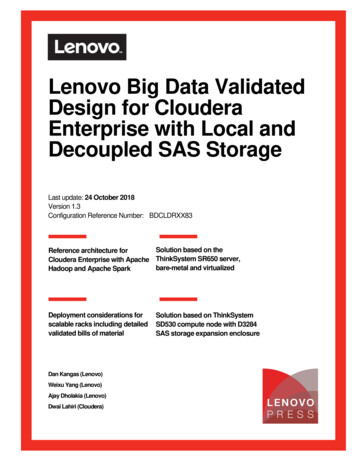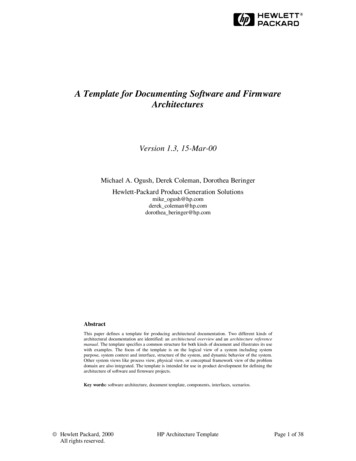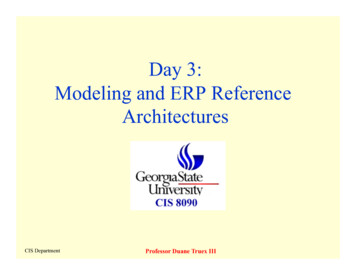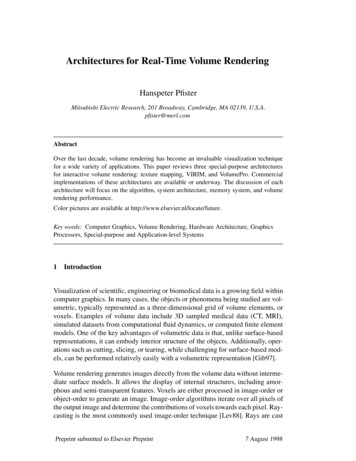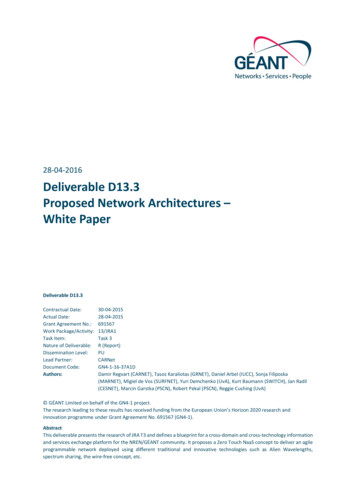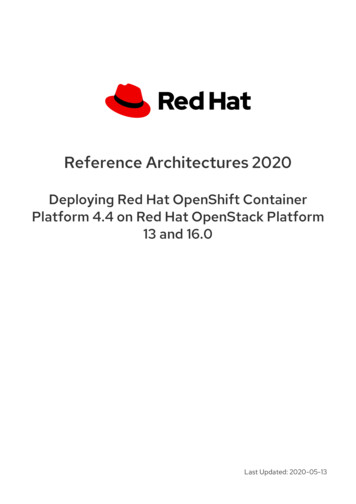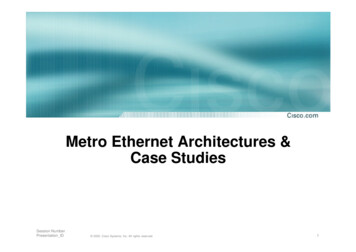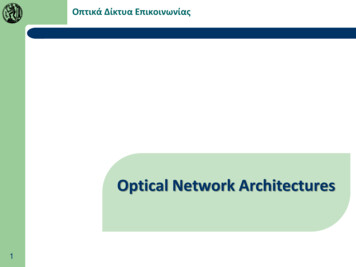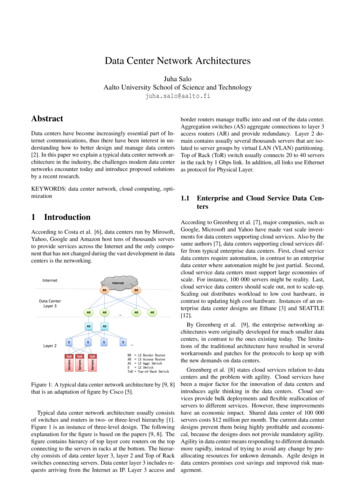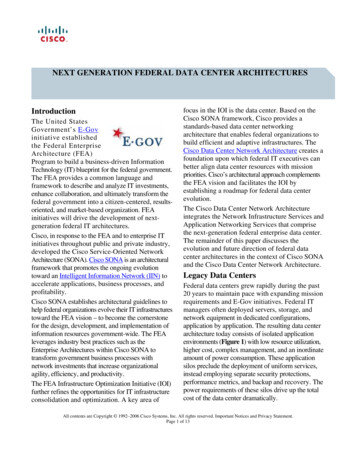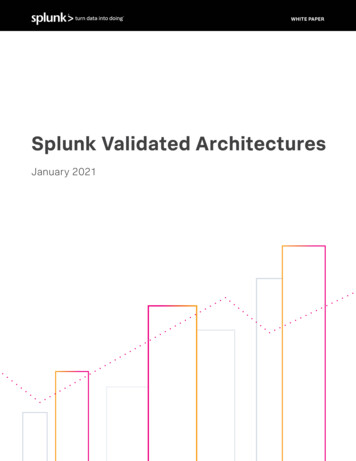
Transcription
WHITE PAPERWHITEPAPERSplunk Validated ArchitecturesJanuary 2021
Splunk Validated ArchitecturesTable of ContentsIntroduction . 2Document Structure .2Reasons to Use Splunk Validated Architectures .3Pillars of Splunk Validated Architectures .3What to Expect From Splunk Validated Architectures .4Roles and Responsibilities .4Available Indexing and Search Topologies . 5Splunk Cloud Deployment Architecture (CLOUD) .6Single Server Deployment (S1) .8Distributed Non-Clustered Deployment (D1 / D11) .9Distributed Clustered Deployment - Single Site (C1 / C11) .11Distributed Clustered Deployment SHC - Single Site (C3 / C13) .13Distributed Clustered Deployment - Multi-Site (M2 / M12).15Distributed Clustered Deployment SHC - Multi-Site (M3 / M13) .17Distributed Clustered Deployment SHC - Multi-Site (M4 / M14) .19Splunk Indexer Architecture Options .21Classic Indexer Architecture Using File System Storage.21SmartStore Indexer Architecture Using Object Storage .22Data Collection Architecture .23Important Architectural Considerations and Why They Matter .23General Data Collection Architecture Guidance .24Data Collection Topology Overview .25Data Collection Components . 26(UF) Universal Forwarder .26(HF) Heavy Forwarder .26(HEC) HTTP Event Collector .27(DCN) Heavy Forwarder as Data Collection Node .29(IF) Intermediary Forwarding Tier .30(KAFKA) Consuming Log Data From Kafka Topics .32(KINESIS) Consuming Log Data From Amazon Kinesis Firehose .33(METRICS) Metrics Collection .34(SYSLOG) Syslog Data Collection.35Splunk Connect for Syslog (SC4S - recommended best practice) .35Syslog (File monitoring in conjunction with a syslog server).37Splunk UDP Input .38High-Availability Considerations for Forwarding Tier components .38Design Principles and Best Practices . 39Deployment Tiers .39Aligning Your Topology With Best Practices.39Best Practices: Tier-Specific Recommendations .39Search Tier Recommendations .40Indexing Tier Recommendations .41Collection Tier Recommendations .42Management / Utility Tier Recommendations .43Summary & Next Steps . 44Appendix . 45Appendix "A": SVA Pillars Explained .45Appendix "B": Topology Components .461
Splunk Validated ArchitecturesIntroductionSplunk Validated Architectures (SVAs) are proven reference architectures for stable, efficient and repeatableSplunk deployments. Many of Splunk's existing customers have experienced rapid adoption and expansion,leading to certain challenges as they attempt to scale. At the same time, new Splunk customers are increasinglylooking for guidelines and certified architectures to ensure that their initial deployment is built on a solidfoundation. SVAs have been developed to help our customers with these growing needs.Whether you are a new or existing Splunk customer, SVAs will help you build an environment that is easier tomaintain and simpler to troubleshoot. SVAs are designed to provide you with the best possible results whileminimizing your total cost of ownership. Additionally, your entire Splunk foundation will be based on a repeatablearchitecture which will allow you to scale your deployment as your needs evolve over time.SVAs offer topology options that consider a wide array of organizational requirements, so you can easilyunderstand and find a topology that is right for your requirements. The Splunk Validated Architectures selectionprocess will help you match your specific requirements to the topology that best meets your organization's needs.If you are new to Splunk, we recommend implementing a Validated Architecture for your initial deployment. If youare an existing customer, we recommend that you explore the option of aligning with a Validated Architecturetopology. Unless you have unique requirements that make it necessary to build a custom architecture, it is verylikely that a Validated Architecture will fulfill your requirements while remaining cost effective.This document contains all SVA topologies that are available at time of publication. For a customdocument that meets your specific requirements, please use the Interactive Splunk ValidatedArchitecture (iSVA) tool available here. The custom document will reflect the best practice approachto search, indexing and data collection architecture, given your specific requirements identified whenworking with the tool.It is always recommended that you involve Splunk or a trusted Splunk partner to ensure that therecommendations in this document meet your needs.If you need assistance implementing a Splunk Validated Architecture, contact Splunk Professional Services.Document StructureSVAs are broken into three major content areas:1. Indexing and search topology2. Data collection architecture components3. Design principles and best practicesIndexing and search covers the architecture tiers that provide the core indexing and search capabilities of aSplunk deployment. The data collection component section guides you in choosing the right data collectionmechanism for your requirements.Design principles and best practices apply to your architecture as a whole and will help you make the correctchoices when working out the details of your deployment.2
Splunk Validated ArchitecturesReasons to Use Splunk Validated ArchitecturesImplementing a validated architecture will empower you to design and deploy Splunk more confidently. SVAs willhelp you solve some of the most common challenges that organizations face, including:Performance Organizations want to see improvements in performance and stabilityComplexity Organizations sometimes run into the pitfalls of custom-built deployments, especially when they have growntoo rapidly or organically. In such cases, unnecessary complexity may have been introduced into theenvironment. This complexity can become a serious barrier when attempting to scaleEfficiency To derive the maximum benefits from the Splunk deployment, organizations must improve the efficiency ofoperations and accelerate time to valueCost Organizations are seeking ways to reduce total cost of ownership (TCO), while fulfilling all of theirrequirementsAgility Organizations will need to adapt to change as they scale and growMaintenance Optimization of the environment is often necessary in order to reduce maintenance effortsScalability Organizations must have the ability to scale efficiently and seamlesslyVerification Stakeholders within the organization want the assurance that their Splunk deployment is built on best practicePillars of Splunk Validated ArchitecturesSplunk Validated Architectures are built on the following foundational pillars. For more information on thesedesign pillars, refer to Appendix "A" below.AVAILABILITYThe system iscontinuouslyoperational and ableto recover from plannedand unplanned outagesor disruptions.PERFORMANCEThe system canmaintain an optimallevel of service undervarying usage patterns.SCALABILITYThe system isdesigned to scale onall tiers, allowing youto handle increasedworkloadseffectively .SECURITYThe system isdesigned to protectdata, configurations,and assets whilecontinuing to delivervalue.MANAGEABILITYThe system is centrallyoperable andmanageable across alltiers.These pillars are in direct support of the Platform Management & Support Service in the Splunk Center OfExcellence model.3
Splunk Validated ArchitecturesWhat to Expect From Splunk Validated ArchitecturesPlease note that SVAs do not include deployment technologies or deployment sizing. The reasoning for this is asfollows: Deployment technologies, such as operating systems and server hardware, are considered implementationchoices in the context of SVAs. Different customers will have different choices, so a generalization is noteasily possible. Deployment sizing requires an evaluation of data ingest volume, data types, search volumes and search usecases, which tend to be very customer-specific and generally have no bearing on the fundamentaldeployment topology. When you are ready, please reach out to Splunk for help with properly sizing yourdeployment based on your expected ingest and search workload profile.Summary of Current SVA Guidance:SVAs will provide:SVAs do not currently provide:Clustered and non-clustered deploymentoptions.Implementation choices (OS, baremetal vs. virtual vs. Cloud etc.).Deployment sizing.Diagrams of the reference architecture.Guidelines to help you select the architecturethat is right for youTier-specific recommendations.Best practices for building out your SplunkdeploymentBest practices for connecting to SplunkCloudA prescriptive approval of your architecture. Note: SVAs providerecommendations and guidelines, so you can ultimately make theright decision for your organization.A topology suggestion for every possible deployment scenario. Insome cases, unique factors may require a custom architecture to bedeveloped. Splunk experts are available to help with any customsolutions you need. If you are an existing customer, reach out toyour Splunk Account Team. If you are new to Splunk, you can reachus here.Roles and ResponsibilitiesSplunk Validated Architectures are highly relevant to the concerns of decision makers and administrators.Enterprise architects, consultants, Splunk administrators and managed service providers should all be involved inthe SVA selection process. You will find a description of each of these roles below:RoleDescriptionEnterprise ArchitectsResponsible for architecting Splunk deployments to meet enterprise needs.ConsultantsResponsible for providing services for Splunk architecture, design, andimplementation.Splunk EngineersResponsible for managing the Splunk lifecycle.Managed ServiceProvidersEntities that deploy and run Splunk as a service for customers.4
Splunk Validated ArchitecturesAvailable Indexing and Search TopologiesNoteIf you chose Splunk Cloud to run indexing and search, the topology for these tiers is chosen by Splunk based onyour licensing agreement. You can jump directly to the section on Data Collection components in this document,which you will still need to consider for getting data into Splunk Cloud.NoteWhile you may choose to implement any topology that provides additional benefits beyond your immediate needs,keep in mind that this will likely result in unnecessary costs. Moreover, the introduction of additional complexity isoften counterproductive to operational efficiency.Important note about topology diagramsThe icons in the topology diagrams represent functional Splunk roles and do not imply dedicated infrastructureto run them. Please see the appendix for guidance as to which Splunk roles can be co-located on the sameinfrastructure/server.5
Splunk Validated ArchitecturesSplunk Cloud Deployment Architecture (CLOUD)The following diagram represents the high-level architecture of a Splunk Cloud deployment and shows theintegration points with your environment:6
Splunk Validated ArchitecturesDescription of the Splunk Cloud Deployment(CLOUD)LimitationsWhen you are chosing Splunk Cloud, all deploymentdecisions regarding your indexing and searchtopologies have already been made for you. TheSplunk Cloud team will build and operate yourdedicated (single-tenant) AWS environment in a waythat allows for meeting Splunk's compliancerequirements and our service SLAs with you.All apps need to be vetted and certified bySplunk to ensure security of your environment.At the time of this writing, 900 apps availableon Splunkbase have been vetted and areSplunk Cloud Certified.The indexers that support your cloud environment aredistributed across multiple fault domains to ensure ahighly available service within a single region (for a list ofsupported regions, refer to the Splunk Clouddocumentation).Besides listening on the standard TCP port (9997) forforwarder traffic, you can also send data via the HTTPEvent Collector (HEC, see details on HEC in the datacollection section of this document). You may alsorequest access to the REST API endpoints via port 8089via a support ticket to support programmatic access.Hybrid Search support is limited to an on-premSearch Head searching Splunk Cloud indexers,not vice versa.The IDM (Inputs Data Manager) shown in thediagram is the Splunk Cloud-managedimplementation of a Data Collection Node(DCN) that supports scripted and modularinputs only. For data collection needs beyondthat, you can deploy and manage a DCN inyour environment using a Splunk HeavyForwarder.Splunk Cloud will not manage or monitor youron-prem Splunk components.The search head(s) are deployed into their ownsecurity group. Depending on your Splunk Cloudservice agreement, that will either be a single searchhead or a search head cluster.If you license a premium app (like the Splunk App forEnterprise Security [ES]), Splunk Cloud will provision adedicated search head as appropriate to meet thepremium app's requirements. If you intend to run ES, youcan forward adaptive response actions to your on- premenvironment using the Adaptive Response Relay asdescribed here.All aspects of operating and managing this AWSenvironment are the responsibility of the Splunk CloudOperations team, so you can focus on onboarding dataand getting value out of your Splunk deployment.Data archiving and restoring is supported.7
Splunk Validated ArchitecturesSingle Server Deployment (S1)Description of the Single Server Deployment (S1)LimitationsThis deployment topology provides you with a very costeffective solution if your environment meets all of thefollowing criteria: No High Availability for Search/Indexinga) You do not have any requirements to provide high- Scalability limited by hardware capacity(straightforward migration path to adistributed deployment)availability or automatic disaster recovery for yourSplunk deploymentb) Your daily data ingest is under 300GB/day andc) You have a small number of users with non-criticalsearch use cas
Splunk Validated Architectures 3 Reasons to Use Splunk Validated Architectures Implementing a validated architecture will

